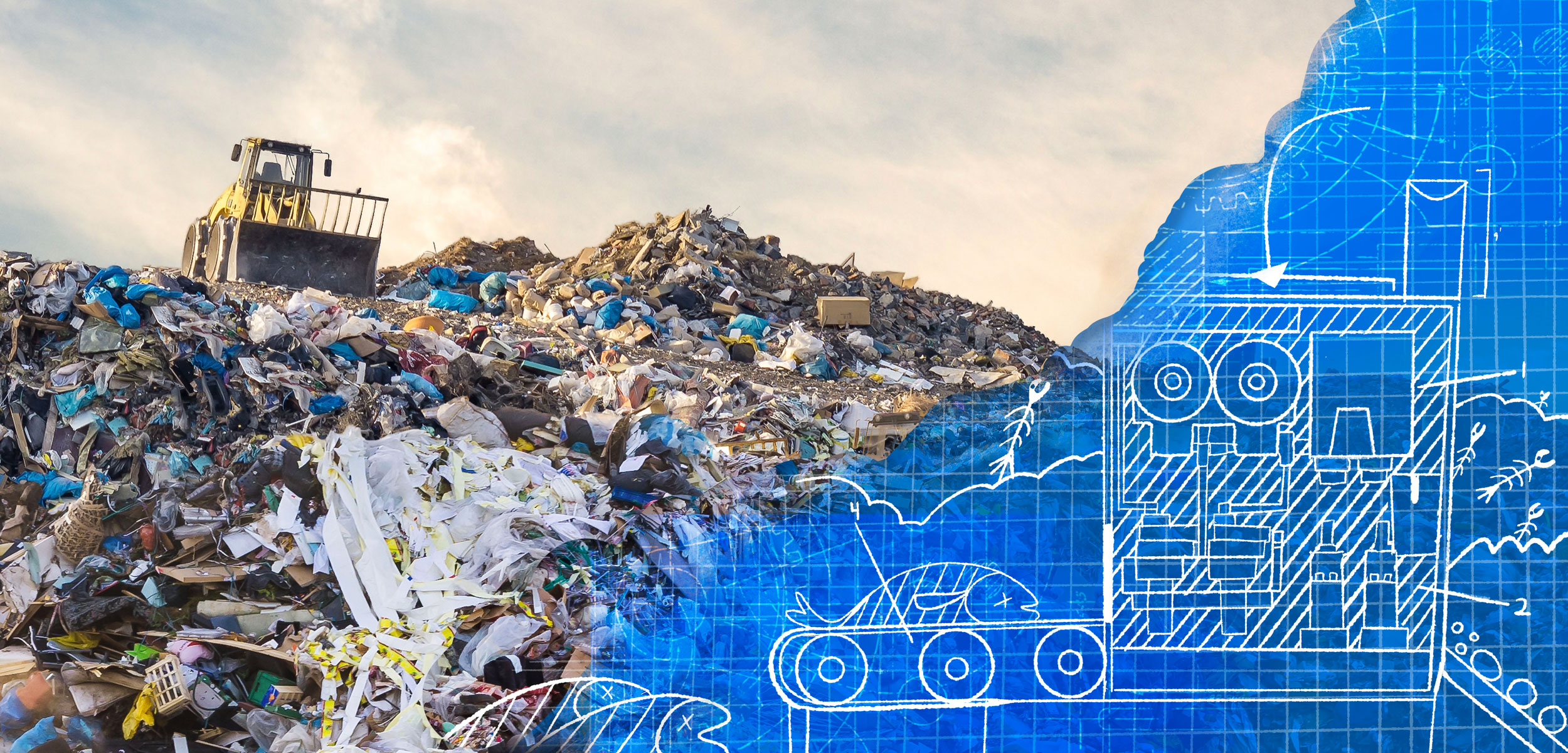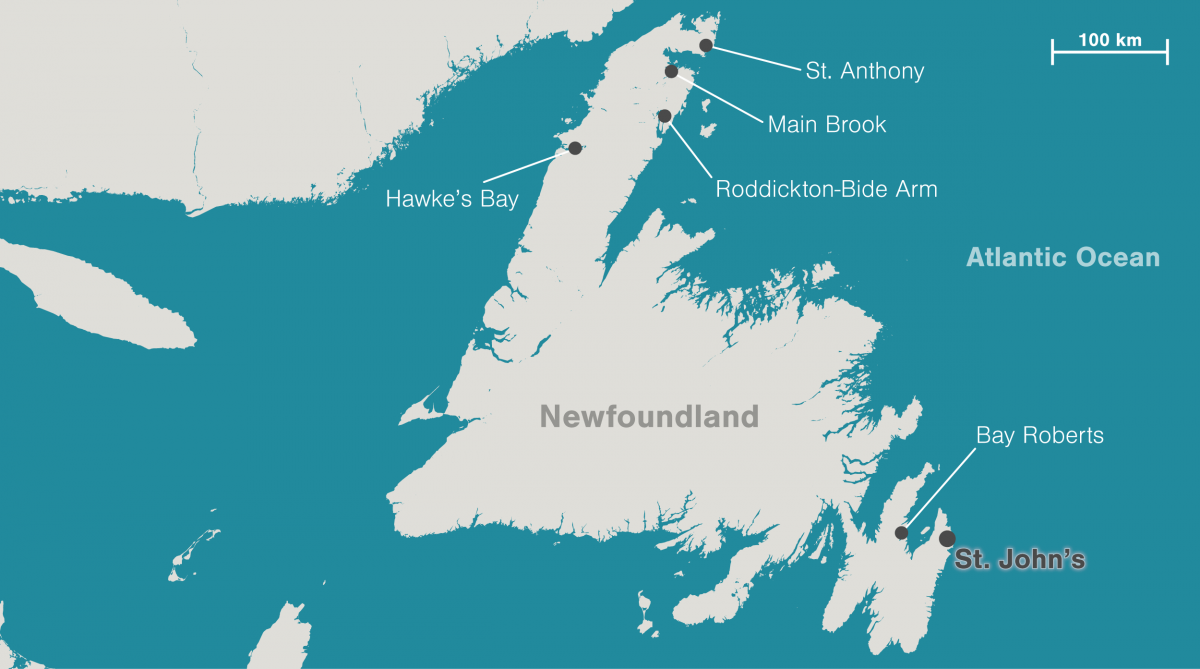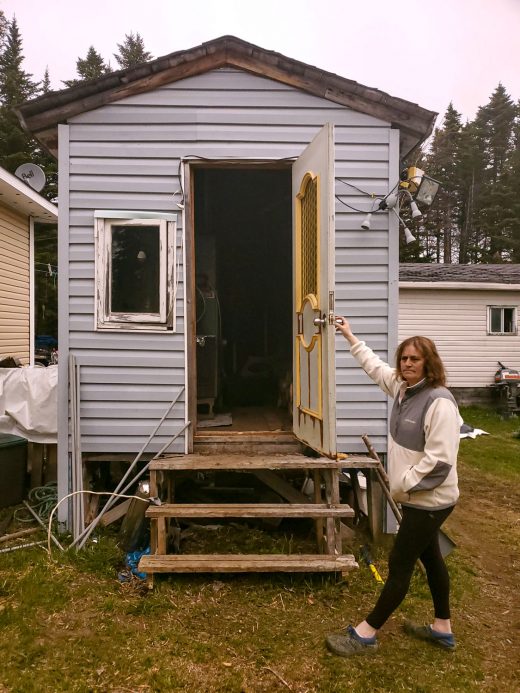The Landfill of the Future
Taking inspiration from science fiction, a small company on the Island of Newfoundland aims to revolutionize what we do with garbage.
Article body copy
The molecular disassembly line works like this: polluted air and water move through a series of tanks, slowly being purified along the way. Between the tanks, hidden from view, grids of submicroscopic, burr-like wheels snag molecules of nitrogen, water, carbon, phosphorus, and other useful elements. Once caught, these elements are sent into the next reservoir, and pollutants stay behind as residue. Finally, once all of the grit and grime have been stripped away, the perfectly clean water, nitrogen gas, and other valuable molecules are ready to be reconstituted using matter compilers—essentially, 3D printers. In this way, the waste of the world, transformed molecule by molecule, can provide a boundless supply of food, clothing, and practical goods for all.
This is waste management as imagined by Neal Stephenson, a science fiction author, in his 1995 novel The Diamond Age: Or, A Young Lady’s Illustrated Primer. While real-world initiatives exist to extract nutrients from wastewater, Stephenson’s vision is still largely fictional. But science fiction does have a long history of propelling and prophesying actual inventions. Stephenson himself coined the concept of the metaverse—a highly addictive, virtual reality iteration of the internet—which is now being doggedly pursued by the likes of Mark Zuckerberg. Feminist author Mary E. Bradley Lane wrote about lab-grown meat in 1880, author H. G. Wells foresaw the atomic bomb, and Ray Bradbury wrote about wireless “thimble radios” that are eerily prescient of Bluetooth earbud headphones. Time and time again, inventors have looked to science fiction as a source of inspiration. And on the Island of Newfoundland’s Northern Peninsula, in the province of Newfoundland and Labrador, a man named Ben Wiper is eyeing Stephenson’s molecular disassembly line as a kind of blueprint—at least, philosophically speaking—for his own waste management company.
To be clear, Wiper isn’t exactly an inventor. Originally from Ontario, the self-described “finance man” arrived in Main Brook, a coastal community of about 240 people on the Northern Peninsula, to co-manage a fish plant in 2017. Ultimately, that partnership didn’t last. But Wiper liked the sweeping isolation of his new home, which—with its small population, teeming wildlife, and relative absence of law enforcement—felt reminiscent of the Wild West, at least to his mind. And so, Wiper thought back to Stephenson’s novel as he plotted his next move, while drawing on all he’d learned about the waste he’d witnessed on the fish-processing line. He reflected on what this abundance of waste could mean in a region with limited economic activity. The result? An ambitious, wide-ranging waste management company Wiper dubbed 3F Waste Recovery.
“3F is founded on the principle that every molecule that comes through our door, we want to have an application for it,” Wiper explains. “My vision is the landfill of the future—where producers can take anything they haven’t processed, to break it down into a form that has a function.”
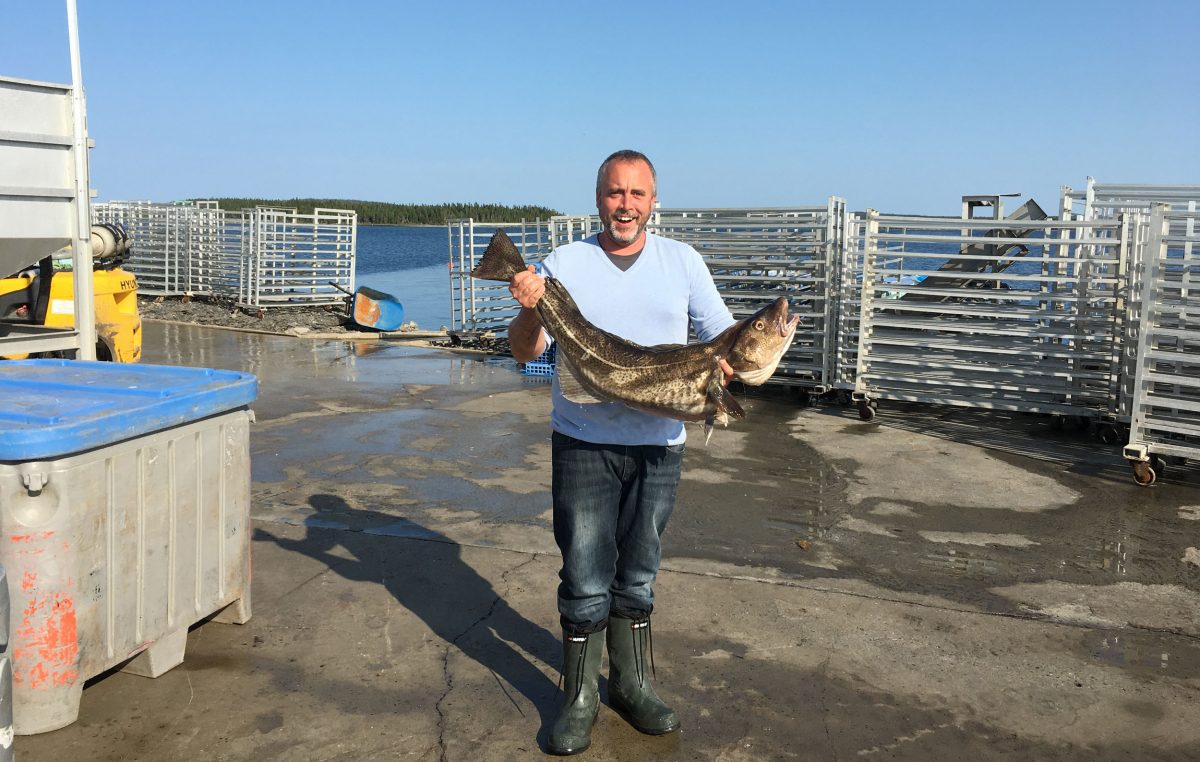
Ben Wiper drew inspiration from his time co-managing a fish-processing plant—and from science fiction—to come up with his waste management model. Photo courtesy of 3F Waste Recovery
The scope of Wiper’s operation folds neatly inside its name: 3F Waste Recovery repurposes waste from fishing, farming, and forestry sectors to create consumer products. For the most part, 3F is currently in a pre-commercial, largely grant-funded stage, focusing more on research, development, and establishing markets, though it has a couple of pilot projects already underway and turning a profit. Wiper’s remote team is primarily scattered across the Northern Peninsula and elsewhere on the Island of Newfoundland. He employs young scientists in St. John’s on the east coast and St. Anthony on the northern tip, fish-plant processors in Bay Roberts (about an hour’s drive west from St. John’s), and laborers on rented farm and forestry sites in Hawke’s Bay and Roddickton-Bide Arm on the Northern Peninsula. Recently, he added more staff into the mix from Nova Scotia and Ontario. Wiper plans to establish production facilities in Main Brook and St. John’s—and possibly even Iceland, if a deal he’s working on goes through—but says no one will need to relocate.
While only a couple of the company’s wares have hit stores yet, 3F has been diligently planning, researching, and building momentum for a wide array of products. Cod waste, the company’s main focus, will be repurposed as a source of marine collagen, as well as cod-skin pet treats, protein powder, and even cosmetics. The bones of farmed sheep (and if legislation allows it, of hunted moose) will either become pet treats or be boiled for their tallow, which can then be used by buyers for making candles and soap. For 3F, sheep wool is also replete with functions. First, the company will be blending cardboard and wool to make slug repellant pellets for the garden. Then, workers will extract and sell lanolin from the fleece. And finally, they’ll card and fluff what remains to stuff sleeping bags, pet beds, and duvets. On the forestry side, 3F is already sourcing sawdust from local sawmills and cardboard from businesses in the region to form pellets and, eventually, briquettes for wood stoves. Any remaining residue, from any of these processes, winds up in the company’s compost.
It might seem like a lot. In the company’s early days, Wiper says, investors told him to focus more—why not stick with, say, the pet treats? But to Wiper, specializing would undermine the whole operation. Because at the end of the day, his suppliers don’t want to be bothered with sorting through waste. “They want to put it in a truck and it disappears,” he says.
“So, if they’re a fish supplier and they do cod, I have to take the heads, I have to take the backbone, I have to take the skins, and if they have the viscera, I’ve got to take the viscera. Otherwise, I’m not as convenient as a landfill.” And because he doesn’t want any waste leaving 3F, either, every scrap of byproduct must have a purpose.
Wiper has honed his message for investors over the past months, inviting them to buy into specialized facets of the operation—gardening products, pharmaceuticals, or pet treats, for example—though his big vision remains a total paradigm shift in waste management. Beyond the practicalities of waste diversion, Wiper believes his holistic approach shows leadership in the circular economy. An emerging global framework, the circular economy model is aimed at keeping materials in circulation, improving the health of ecosystems, and reimagining waste as a resource rather than an unwanted endpoint. Wiper says 3F had actually been in motion for two years before he first heard the term circular economy used at a conference. Though he landed on the language of the circular economy after brainstorming his business model, Wiper feels the framework fits 3F perfectly—and he emphatically supports the model’s principles. As he tells me gravely on the phone at one point, humanity must transition to a completely circular economy, “or we’re going to die.”
Janice Saunders, 3F’s national sales manager, is shuffling through Scentsy air fresheners at the Main Brook gas station when we first meet in May 2021. She reads one label aloud—“Wild, barefoot, and free”—laughs, and settles on as many berry-flavored scents as she can carry. “I have 60 pounds [27 kilograms] of cod skins in my basement,” Saunders explains. Part of her job involves distributing orders of 3F’s cod-skin pet treats across Newfoundland, and at that scale, the products can be stinky.
Saunders has worked with 3F for nearly two years. A native of St. Anthony—a community of about 2,200—she left the province for work after graduating from high school. Saunders spent 18 years in Ontario and Alberta, mainly working in restaurants, before coming home with her kids about six years ago. Before joining 3F, she was working for minimum wage at a restaurant. Now, she and everyone else at 3F earn at least CAN $20 an hour. For a region with the second-highest unemployment rate in Canada—and a median income of about $30,000 a year—these kinds of wages and opportunities are especially significant.
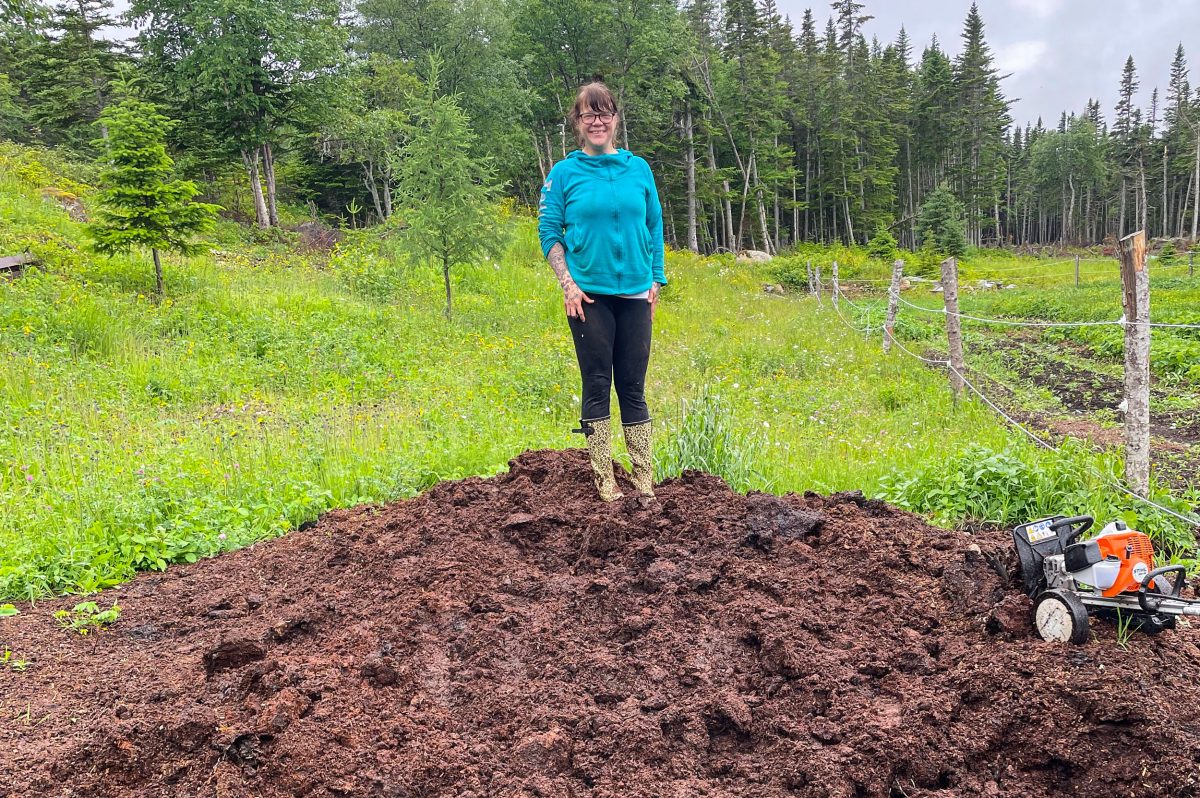
Janice Saunders, a full-time national sales manager for 3F Waste Recovery—plus part-time compost shoveler, fish-guts grinder, or sheep-bone smasher—stands on a heap of compost. Photo courtesy of 3F Waste Recovery
Together, Saunders and I drive about 40 kilometers to a midway point between Main Brook and St. Anthony, where we meet up with Wiper and Hailee Keats, 3F’s office administrator, who have come from the opposite direction. Nearly two hours and many caribou sightings later, the four of us arrive at Zero Waste Farms in Hawke’s Bay, halfway down the peninsula. 3F rents the site from farmer Mike Offrey, who co-manages the waste farm. Though Offrey grows vegetables here on his own, 3F’s purpose at this site is mainly gathering and reusing farm byproducts.
The team doesn’t come here too often, so everyone takes a quick look around. Sheep skulls—relics of last fall’s experiments with soap, wool, and tallow—are scattered across the muted, barely-there yellow of the ground. On a mossy bank lie two steel rails from old island train tracks, crisscrossed together like skis slowing down. The Newfoundland provincial railway was discontinued in 1988, but its remnants still linger; later, Offrey explains that these particular rails bore the weight of greenhouses he once ordered from central Newfoundland.
Today’s mission is packaging 3F’s seafood compost, which lies before us in various tall, heaping mounds. Together, Wiper, Saunders, and Keats brainstorm ideas for how to do this efficiently. Should they hang up a hollowed-out bucket as a hopper, in hopes of streamlining the flow of the compost? Or should they just scoop the compost directly into plastic bags and weigh it? As this conversation ensues, the team also plots today’s live-streaming scenes for 3F’s Facebook page.
Wiper is curiously nervous about packaging the compost. “I’ve never done this before,” he explains. “I’m a perfectionist. And when I’ve never done something before, the odds of failure are extremely high.”
Coupling that uncertainty with live streaming seems an odd choice, but Wiper explains that its part of his process. “I just force it on myself, jump in, and deal with it,” he says.
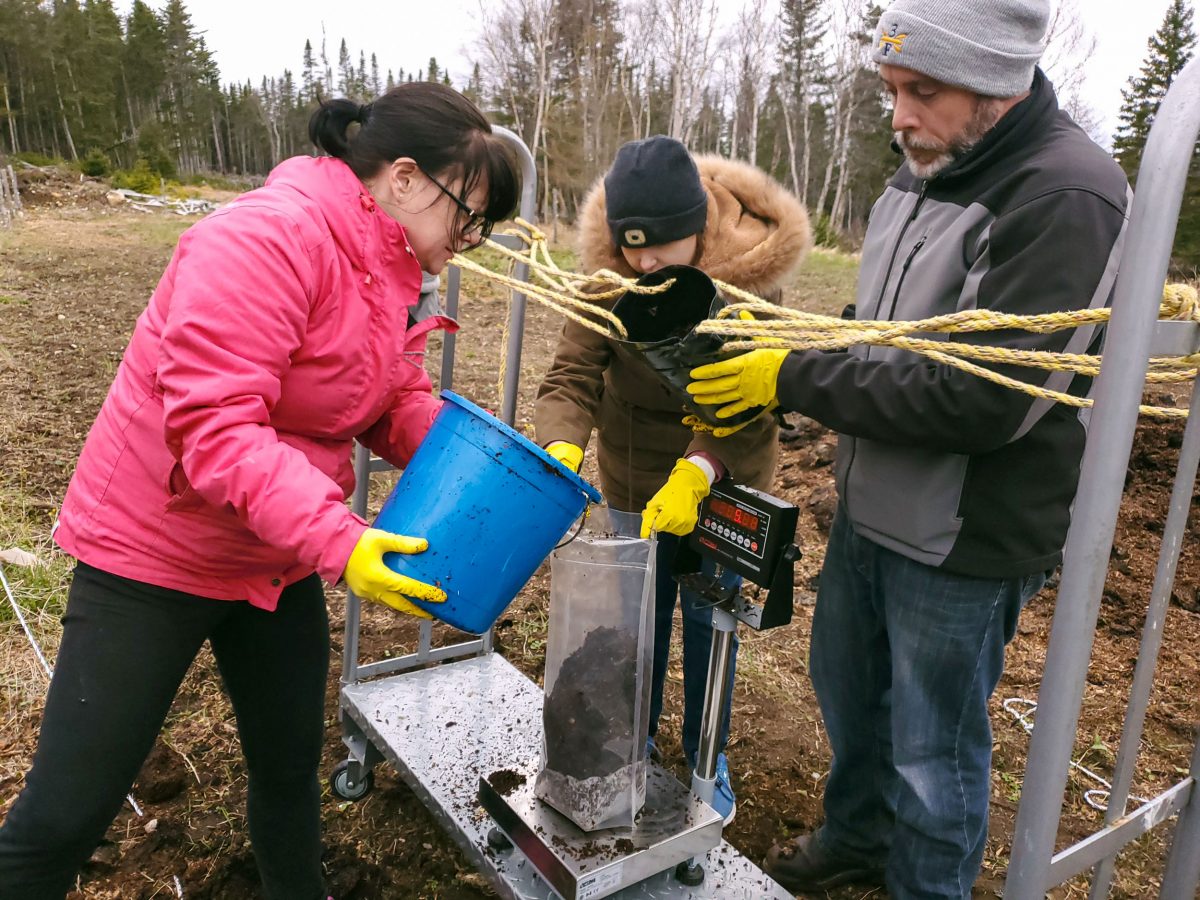
The 3F Waste Recovery team tests out a hopper system for filling bags of compost. Photo by Andrea McGuire
The team opts to try out the hopper setup. In the meantime, some of us start digging at the compost, which has been maturing for a few months, with trowels and shovels. Saunders and Keats may be office staff at 3F, but they have zero hesitation when it comes to dealing with compost, or, say, hammering moose bones for tallow, or running lumpfish and cod bits through the company woodchipper. Every so often, someone snags a fish that hasn’t yet decomposed, filling the air with a terrible scent. Saunders says it’s nothing compared with the face full of steam she got one time from a batch of boiling sheep’s wool. That, she says, smelled like “a thousand million barns, all put into one little pot.”
It soon becomes clear that the hollowed-out bucket as a hopper isn’t working. Still, Wiper powers through and records the result.
“It ended up that if we just use a bucket, pour [the compost] in, and then finish it up to the 10 pounds [4.5 kilograms] on the scale, I think that’s going to be our fastest way,” he says to about 120 viewers via live stream. Wiper may like to be perfect, but he’s still transparent when plans go awry. Later, he explains that while perfectionism used to inhibit him, he now accepts failure as a necessity on the path to success. Case in point: in August 2020, one of 3F’s videos went viral on a couple of “fail sites”—basically, websites of embarrassing videos from across the internet—and even this he takes in stride.
The video features his compost-tumbling invention. Six octagonal compost bins strapped to a set of gears are supposed to continuously rotate—but as the chain keeps slipping, the bins jerk and snap back and forth instead. But the video has now had more than seven million views. “And now we’ve got all kinds of new people from all around the world that like 3F and know what we’re up to,” Wiper says. “I do get a lot of satisfaction in knowing that every set of eyeballs that sees what we’re doing is another person who could contribute to the circular economy in the future.”
At the edge of the compost piles, an old fish bucket—once split apart near the corner—has been carefully mended with stitches of twine. For gardeners in Newfoundland, one of these rectangular plastic bins with a bit of rope tied to the end can be the next best thing to a wheelbarrow. Generally speaking, they’re easy to find (and, therefore, replace) in many parts of the island. Anyone who’d like one can usually head down to a wharf and ask around.
Offrey, the farmer, confirms he sewed up the bucket. It’s not a big deal. Why wouldn’t he fix it?
That spirit of resourcefulness is easy to see on Newfoundland’s Northern Peninsula, especially as you’re traveling along its highway. When the road was initially constructed in the 1960s, it cut through the region’s bogs and barrens—flinging a bounty of rich, fertile peat to the highway’s edges. Residents quickly swept in, planting their potatoes, cabbages, carrots, and other root vegetables in the uncommonly arable soil, and setting up fences to keep animals out—even though all of these roadside gardens are technically situated on Crown land.
Wiper and Saunders say the level of self-sufficiency on the peninsula makes it the kind of place where it’s hard to work as a plumber, simply because everyone knows how to do the job themselves. And in his first days of co-managing the fish plant in Main Brook, Wiper was taken aback after deciding to order building materials for a smoke shack so his employees wouldn’t have to smoke outside in bad weather. Mere hours later, he found a shack built with, as he describes it, “stuff that people from around town picked over in their backyard.”
At 3F, two employees are especially inspiring to Wiper for their ability to “make something out of nothing.” Bev and Alfie Pilgrim from Main Brook construct their own buildings; cut their own firewood; and hunt, fish, and forage at least 50 percent of their food. Alfie has also salvaged two boats from the bottom of the ocean. One of them is a fiberglass speedboat. “It’s a $100,000 boat brand new,” Wiper says.
Alfie (first photo) and Bev Pilgrim are among Newfoundland’s expert salvagers. Photos by Andrea McGuire
At the Pilgrims’ farm, their ingenuity is on full display. “My dear, we salvage everything,” Bev confirms. “Alfie can come up with anything.” She gives me a tour of their yard, highlighting a firepit made from a hot-water tank welded to a snowmobile’s legs, a bird feeder made of hydro-pole insulators, scallop shells repurposed as ashtrays, and a smaller boat built from scrap wood. The couple has materials for future projects assembled in piles, resting against tree trunks and hanging from branches. The whole place feels like an inventor’s workshop.
The Pilgrims still found time to work for 3F this past summer—building a test garden to evaluate 3F’s compost, and collecting raw materials like sawdust, shells, and fish waste on their quad. When I ask what she thinks of 3F, Bev smiles: “Pretty cool is what I call it,” she says.
Nicholas Lynch, a geography professor at Memorial University in St. John’s, says circular economy ideology is gaining traction around the world. Since critics argue that true sustainability is incompatible with growth and development, policymakers are gravitating toward the language of “closing waste loops” in the circular economy model instead of relying on terms like sustainable development, Lynch says. But while his own research champions many of the possibilities of the circular economy, Lynch bristles at the notion that this model is anything new. “It’s talked about as this brand-new idea, and it’s not,” Lynch says. “And so the history of it matters.”
“If we stay [focused] on the coast,” he adds, “like any coastal people—out of necessity, salvaging and reusing is, [and] was, just part of life. Right? So the circular economy, if you call it that, has been going on forever.”
Rebecca LeDrew, a former graduate student of Lynch’s, researched circular economies in the Netherlands and Scotland for her master’s thesis. When it comes to waste recovery, LeDrew says, while there’s a recent tendency to focus on new technologies, much can be gleaned from older traditions of reuse—such as composting and repurposing building materials.
“Everything doesn’t have to be new and shiny and highly innovative,” she says. “You can find solutions in older practices.”

Pet treats made from cod waste are one of 3F Waste Recovery’s signature products. Photo courtesy of 3F Waste Recovery
LeDrew commends 3F for connecting with fishers, foresters, and farmers in the area. “They’re not trying to recycle electronics or something like that out in the middle of rural Newfoundland. They’re looking at, Hey, what’s here? And what can we do with what’s here? So I mean, that’s a really intelligent and feasible approach to circularity,” she says.
According to Lynch, this potential for building relationships with primary industries along the coast could prove key for other coastal waste recovery initiatives, too—especially as pressure mounts for various industries to become better environmental stewards. The oil and gas industry, for example, is looking to recover useful minerals like lithium and magnesium from its wastewater. Really, the fictional catalyst for 3F could become less and less fictional with every passing day.
Sci-fi often paints the future as an increasingly virtual dystopia. But a book like The Diamond Age pulses with inventive possibilities that could lead to more grounded, ecologically sound possibilities, too. For Wiper, the sparsely populated Northern Peninsula is the best place to nurture his utopic, sci-fi–inspired ideals. Here, he and his team are less shackled, less constrained than they’d be in a denser, more centralized region, he says. There’s plenty of space for experimenting—which is an important consideration, since, as Lynch tells me, “experimentation is absolutely crucial” for the circular economy. And 3F’s experimental vision is, increasingly, gaining the attention of movers and shakers in the circular economy sphere. A collaborative report led by the Smart Prosperity Institute—a research network and policy think tank at the University of Ottawa in Ontario—included 3F in its scan of almost 200 notable circular economy agri-food solutions across the country. Of these 200 operations, research associate Sonia Patel says 3F “was identified as one of the more innovative solutions.”
3F’s commercial prospects seem promising, too. An international, multimillion-dollar deal for pet treats looms on the horizon and could add 40 more rural, full-time jobs to 3F’s ranks. As we drove along the highway together, Wiper, Keats, and Saunders fielded a flurry of calls and emails from potential buyers, patiently dealing with the peninsula’s wobbly cell service as it went in and out.
Still, Wiper says 3F will soon have to start turning more of a profit. While grants and a COVID-19 emergency-wage subsidy have fueled the company’s research over the past year and a half, Wiper says they’ll need to start generating more revenue through sales or investments soon. But all the same, he remains “very optimistic” about the future of 3F. And like the novelist who first inspired him, Wiper brings a sense of creativity and inventive problem solving to his daily work. His latest endeavor is creating a brand-new fish-processing model, which he’s calling Fisheries 2.0. Under this system, a single plant devoted to cod (for example) would fulfill every possible aspect of processing—including everything from packaging fillets, tongues, cheeks, and fish sticks to producing cod collagen, protein powder, and pet treats. And to enhance the freshness of all these products, he’d like to use helicopters to pop portable processing plants directly onto fishing vessels.
If Wiper succeeds in bringing this big idea to life with cod, he says it could serve as a model for other community-based fisheries. He welcomes competition and actively hopes others will replicate his work on Fisheries 2.0, applying it to, perhaps, the lobster fishery or urchin fishery. The more momentum there is to recognize the value of waste, the better for everyone. Because 3F can’t do it all, he says, and for now, the world has far too much waste to go around.

